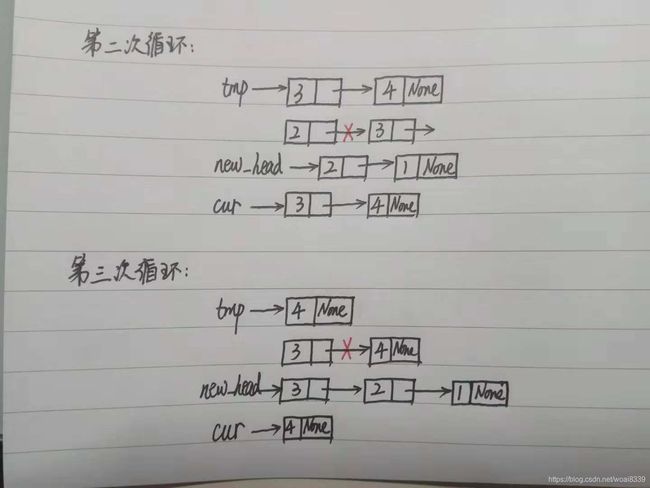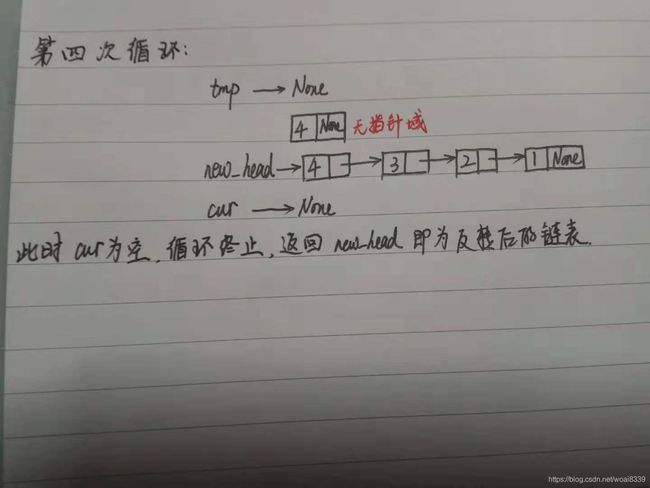一文搞定链表面试题(不定期更新链表提醒及解题思路大杂烩)Middle of the Linked List\合并有序链表\链表反转\删除链表元素
链表题目集锦
- 返回链表中间数
- 借助列表实现
- Java借助链表长度实现
- Python指针解法
- 链表反转
- 借助Python列表反转链表
- 就地反转链表
- 合并两个有序链表
- 列表实现
- 递归实现
- 删除链表中的特定元素
- Python列表实现
- 递归实现[5]
返回链表中间数
题目:返回列表中间数,如果链表长度为奇数,中间数即为中间位置的数值。如果链表长度为偶数,则返回是链表中间两位偏向于右边的数值[1]。
Leetcode链接
直接上代码吧,后期不定期更新链表相关题目。
借助列表实现
class Solution:
def middleNode(self, head):
nodes = []
while head is not None:
nodes.append(head)
head = head.next
# node = nodes[len(nodes)//2]
# return node
return nodes[len(nodes)//2]
一个完整案例代码如下:
#
#
# Definition for singly-linked list.
from pandas import json
class ListNode:
def __init__(self, x):
self.val = x
self.next = None
class Solution:
def middleNode(self, head):
nodes = []
while head is not None:
nodes.append(head)
head = head.next
# node = nodes[len(nodes)//2]
# return node
return nodes[len(nodes)//2]
def stringToIntegerList(input):
return json.loads(input)
def stringToListNode(input):
# Generate list from the input
numbers = stringToIntegerList(input)
# Now convert that list into linked list
dummyRoot = ListNode(0)
ptr = dummyRoot
for number in numbers:
ptr.next = ListNode(number)
ptr = ptr.next
ptr = dummyRoot.next
return ptr
def listNodeToString(node):
if not node:
return "[]"
result = ""
while node:
result += str(node.val) + ", "
node = node.next
return "[" + result[:-2] + "]"
def main():
import sys
def readlines():
for line in sys.stdin:
yield line.strip('\n')
lines = readlines()
while True:
try:
line = next(lines)
head = stringToListNode(line);
ret = Solution().middleNode(head)
out = listNodeToString(ret);
print(out)
except StopIteration:
break
if __name__ == '__main__':
main()
Java借助链表长度实现
class Solution {
public ListNode middleNode(ListNode head) {
if(head == null) return head;
int len = 0;
ListNode current = head;
while(current != null) {
len++;
current = current.next;
}
len /= 2;
current = head;
while(len > 0) {
current = current.next;
len--;
}
return current;
}
}
Python指针解法
# Definition for singly-linked list.
# class ListNode:
# def __init__(self, x):
# self.val = x
# self.next = None
class Solution:
def middleNode(self, head):
"""
:type head: ListNode
:rtype: ListNode
"""
tmp = head
while tmp and tmp.next:
head = head.next
tmp = tmp.next.next
return head
后续有时间更新链表定义、常见题型及解题方法
----------------------我是分割线-------------------------
链表反转
题目:给定一个单链表,求该链表反转后的链表。Leetcode链接
此题需要先确定是否能够独立开辟空间或者新建链表。分两种情况作答。
首先,链表在python中有两种表达方式,一是用类建立节点,定义两个指针进行表达,另一个是用列表表达。分别采用两种方式进行解析:
借助Python列表反转链表
我们可以这么来想:每遍历一次链表,将链表的数值域的数值存储到一个列表中,这样链表遍历完成后即生成一个顺序链表元素的列表,然后再将列表反转输出就可以了。
代码如下:
# Definition for singly-linked list.
# class ListNode:
# def __init__(self, x):
# self.val = x
# self.next = None
class Solution:
def reverseList(self, head):
"""
:type head: ListNode
:rtype: ListNode
"""
result=[]
while head is not None:
result.append(head.val)
head = head.next
result = result[::-1]
return result
但是该种解法因为要遍历链表,时间复杂度O(n)。因为要新开辟一个列表,并且要写入与原链表同等长度的元素,故而空间复杂度也为O(n)。
就地反转链表
之前的解法是O(n)空间,我们可以用O(1)空间完成这件事情。举个例子,方便理解(手写了下):


 依据此思路,写代码如下:
依据此思路,写代码如下:
# Definition for singly-linked list.
# class ListNode:
# def __init__(self, x):
# self.val = x
# self.next = None
class Solution:
def reverseList(self, head):
"""
:type head: ListNode
:rtype: ListNode
"""
if head == None or head.next == None:
return head
else:
cur = head
new_head = None
tmp = None
while(cur):
tmp = cur.next
cur.next = new_head
new_head = cur
cur = tmp
return new_head
合并两个有序链表
题目[3]:
列表实现
思路:就是将链表数值分别放置在两个链表空间种,然后合并成为一个列表再排序。直接上代码:
# Definition for singly-linked list.
# class ListNode:
# def __init__(self, x):
# self.val = x
# self.next = None
class Solution:
def mergeTwoLists(self, l1, l2):
"""
:type l1: ListNode
:type l2: ListNode
:rtype: ListNode
"""
result1 = []
result2 = []
result = []
while l1 is not None:
result1.append(l1.val)
l1 = l1.next
while l2 is not None:
result2.append(l2.val)
l2 = l2.next
result = result1 + result2
result.sort()
return result
一个优化的地方可以只借助于O(max(m,n))的空间,直接上代码如下:
# Definition for singly-linked list.
# class ListNode:
# def __init__(self, x):
# self.val = x
# self.next = None
class Solution:
def mergeTwoLists(self, l1, l2):
"""
:type l1: ListNode
:type l2: ListNode
:rtype: ListNode
"""
result = []
while l1 is not None:
result.append(l1.val)
l1 = l1.next
while l2 is not None:
result.append(l2.val)
l2 = l2.next
result.sort()
return result
至于Python里sort究竟如何实现排序的,我会抽空写一篇博客单独讲讲排序及在Python/Java/Scala种内置函数的源码实现和八大排序实现。
递归实现
删除链表中的特定元素
题目:给定一个链表的头节点head和删除的元素值val,返回删除所有val之后的链表。
Python列表实现
# Definition for singly-linked list.
# class ListNode:
# def __init__(self, x):
# self.val = x
# self.next = None
class Solution:
def removeElements(self, head, val):
"""
:type head: ListNode
:type val: int
:rtype: ListNode
"""
cur = head
result = []
while(cur):
if cur.val != val:
result.append(cur.val)
cur = cur.next
return result
时间复杂度、空间复杂度都是O(n)。
递归实现[5]
Java实现:
public ListNode removeElements(ListNode head, int val) {
if (head == null) return null;
head.next = removeElements(head.next, val);
return head.val == val ? head.next : head;
}
改写为Python实现:
# Definition for singly-linked list.
# class ListNode:
# def __init__(self, x):
# self.val = x
# self.next = None
class Solution:
def removeElements(self, head, val):
"""
:type head: ListNode
:type val: int
:rtype: ListNode
"""
if head is None:
return head
if (head.val == val):
return self.removeElements(head.next, val)
else:
head.next = self.removeElements(head.next, val)
return head
def stringToIntegerList(input):
return json.loads(input)
def stringToListNode(input):
# Generate list from the input
numbers = stringToIntegerList(input)
# Now convert that list into linked list
dummyRoot = ListNode(0)
ptr = dummyRoot
for number in numbers:
ptr.next = ListNode(number)
ptr = ptr.next
ptr = dummyRoot.next
return ptr
def listNodeToString(node):
if not node:
return "[]"
result = ""
while node:
result += str(node.val) + ", "
node = node.next
return "[" + result[:-2] + "]"
def main():
import sys
import io
def readlines():
for line in io.TextIOWrapper(sys.stdin.buffer, encoding='utf-8'):
yield line.strip('\n')
lines = readlines()
while True:
try:
line = next(lines)
head = stringToListNode(line);
line = next(lines)
val = int(line);
ret = Solution().removeElements(head, val)
out = listNodeToString(ret);
print(out)
except StopIteration:
break
if __name__ == '__main__':
main()
Ref:
1、取链表中间数
1.2、参考Leetcode的Java解法
1.3、参考Leetcode的Python解法
2、链表反转
3、合并两个有序链表
4、移除链表中的特定元素
5、递归实现移除链表中特定元素